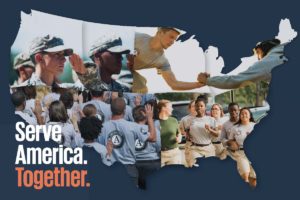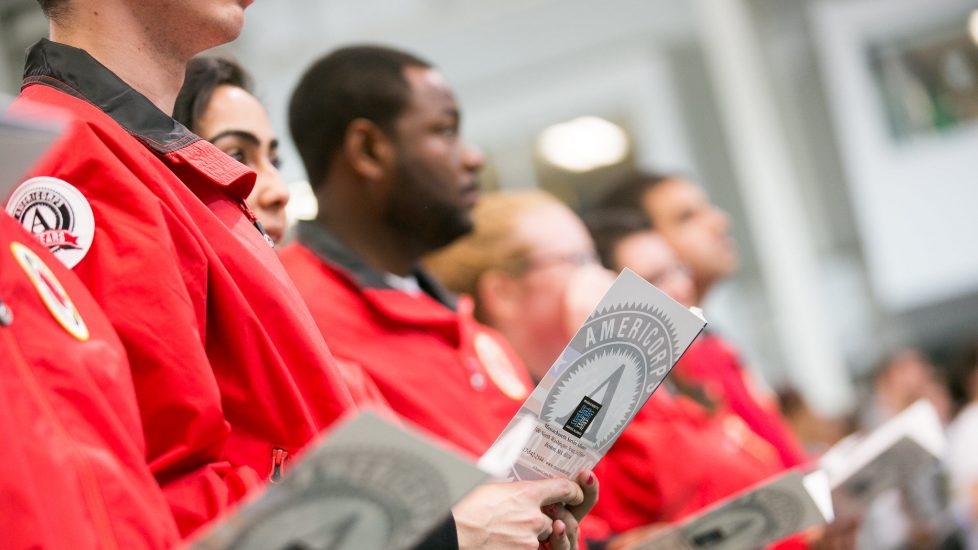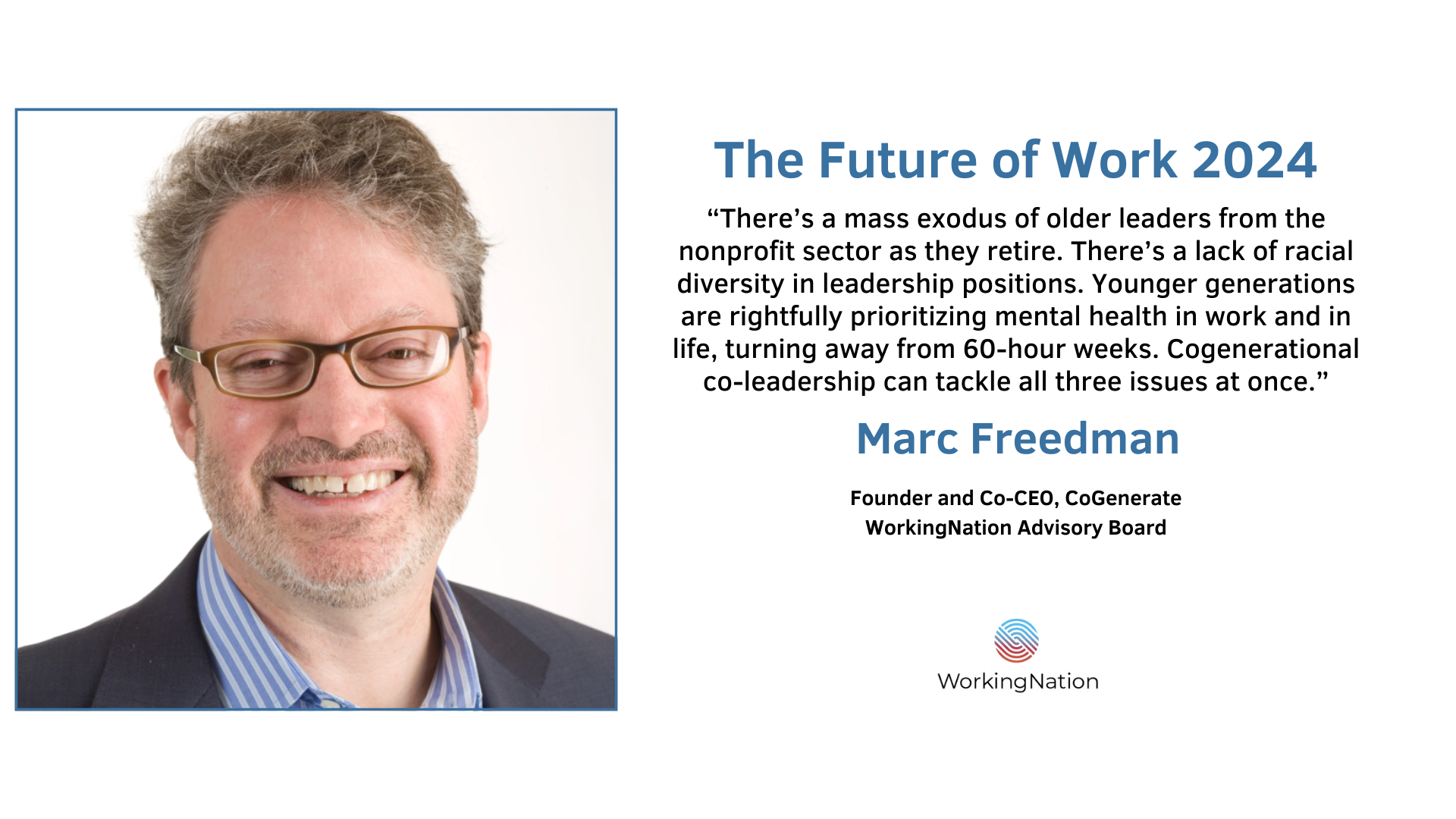Each year, more than 66,000 Americans complete a service year with programs such as AmeriCorps, Habitat for Humanity, and Teach for America. The Serve America Together campaign, launched today, wants to make voluntary national service — including civilian, military, and public service — part of growing up for all young Americans.
The campaign, led by the Service Year Alliance, is chaired by a bipartisan group of co-chairs including Gen. (Ret.) Stan McChrystal, former U.S. Secretary of Defense Robert Gates, former Massachusetts Governor Deval Patrick, and Arianna Huffington. It is supported by a coalition of military and civilian service organizations, including The Mission Continues, Veterans for American Ideals, America’s Service Commissions, The Corps Network, YouthBuild, Voices for National Service, and The National Peace Corps Association.
What are the goals and benefits of Serve America Together?

Serve America Together aims to build awareness, engage presidential candidates, empower communities, and work with Congress to pass legislation that will make national service a common expectation and opportunity for all young Americans. Campaign organizers describe national service as paid, work-based learning that will help young adults develop real-world skills while serving society.
Alumni of AmeriCorps agree. Nine out of 10 alumni say their experience improved their ability to solve problems, one of the soft skills employers are looking for in their workers. Eight out 10 alumni say AmeriCorps advanced their career path.
Another study, this one by Burning Glass Technologies, shows that a quarter of service year alumni go on to earn a bachelor’s degree after their service year, compared to 11 percent of their peer group. The same study shows that the alumni are more likely than their peers to cite skills related to leadership on their resumes as they are entering the workforce.
Burning Glass says its “report shows that service programs, rather than being a detour for students, can actually boost education and social service careers by providing crucial skills and experience. In addition, service programs may prove to be a useful way of getting people without a bachelor’s degree back on track.”
Why Now?
According to statistics provided by Serve America Together:
- Approximately 71 percent of 17-to-24-year-olds in the U.S. would not qualify for military service because of reasons related to health, education, involvement in the criminal justice system, and other factors — and they are unaware of other ways to serve.
- We’re facing a college affordability crisis.
- Millions of young people are out of work.
What Does a Service Year Looks Like?
In December, Service Year Alliance hosted an Opportunity Youth Summit that focused on how service years can put people who are out of work and out of school on a pathway to educational and job opportunities. Amanda Young is just one of many people who say they found their calling through national service.
Service Year Alum – Amanda Young, AmeriCorps VISTA
After graduating from West Virginia University, Amanda had trouble finding stable employment. She lost her part-time job at a restaurant and her financial st…
After graduating from West Virginia University, Young had trouble finding stable employment. She lost her part-time job at a restaurant and her financial struggles left her sleeping on friends’ couches without a home to call her own. Things turned around when she found an opportunity to serve with AmeriCorps VISTA.
She went on to do two service years at an adult literacy nonprofit in West Virginia where she coordinated hundreds of volunteers in workshops and events. Now, Young leads her own AmeriCorps VISTA program at West Virginia University.
Serve America Together says, “expanding national service will empower young people to shape their own futures through national service opportunities.” There are hundreds of organizations that help local communities tackle issues like education, health care, disaster preparedness, and environmental concerns through service years.
For example, in New York City’s most crime-troubled neighborhoods, Green City Force, is a service year program in which corps members teach environmental sustainability practices — all the while learning essential job skills for the workforce.
Service Years Build Workforce Skills
In New York City’s most crime-troubled neighborhoods, service year corp members are teaching their neighbors environmental sustainability practices – all the…
The organizers also believe that service years can, and should, help members of the U.S. Armed Forces transition out active duty into civilian life, and that opportunity should be inclusive of military spouses.
How Would Young Americans Be Rewarded?
Organizers believe that young Americans should be rewarded for their service, earning access to high education. “Comprehensive, earned benefits might depend on the type and duration of service, but they should be an integral component to a system of universal voluntary national service.”
“When national service is a way to earn debt-free education, be it in universities, community colleges, vocational schools, or other certification institutions, more young Americans will be on the path to achieving the American dream while addressing unmet challenges in our communities and serving our country,” according to Service America Together.
Organizers also believe in protecting existing earned benefits for service, including the Forever GI Bill and the Segal Education Award.
How Much will Voluntary National Service Cost?
The campaign cites a 2013 study by Columbia University, which says “national service returns about $4 in social benefits for every dollar invested by the federal government.”
Additionally, organizers say “to expand service years from 66,000 members to 200,000 members would cost approximately an additional $3 billion, bringing the total federal investment to $4.5 billion. Federal agencies can use national service to perform service that aligns with agency missions at a low cost, like FEMA Corps, which is estimated to save $60 million annually, according to FEMA.”
What Do Americans Think About the Idea?
According to polling data provided by Serve America Together:
- 63 percent of Americans support the establishment of a universal national service system.
- 1 in 4 young Americans would definitely serve if given the opportunity.
- 75 percent of Americans support national service as a strategy to address unmet needs in our communities and empower the individuals serving.
- 61 percent of voters are more likely to vote for a candidate who would guarantee funding to establish a service position for every qualified national service applicant.
How is the Campaign Working with Local Leaders?
Serve America Together organizers say they are working with governors, state officials, mayors, and other local officials to create national service plans. “These national service plans are business plans for service and function as roadmaps for communities to make a year of service a common expectation and opportunity locally, with community needs in mind.”
On the national level, the campaign is calling on all 2020 presidential candidates to release their national service plans and make national service a priority in their first 100 days in office.
You can read more about the campaign here: Serve America Together.
Related Article:
How service years bridge the gap between opportunity youth and jobs – WorkingNation
If there’s one thing we’re all learning as the impacts of the Fourth Industrial Revolution unfold on today’s workforce, it’s that there are many pathways to a career beyond school. One of those pathways that deserves more attention and support is service year programs. Service year programs offer young people the opportunity to gain real-world skills while holding paid, full-time jobs that help make a difference in their communities.











